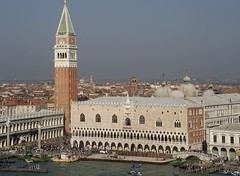 Image via Wikipedia
Image via Wikipedia By
Sarah Dudleymore
'The Vaporetto'
In this amazing world wonder city on water probably the best way to get around (if you don't want to walk a full day) is the "Vaporetto".
The Vaporetto is a boat that is like a bus except it stops at a pier to pick up passengers.
A one way ticket costs 6.50 euro (2008 price) each way per person for any line along the Grand Canal, valid for up 60 minutes.
Before boarding a 'Vaporetto', you must stamp your ticket in a little yellow box, found on both sides of the platform. If you forget to do so, tell the guy that ties the boat to stamp it for you. By doing this, you will avoid a fine of EUR30 if you get checked by the ticket-person while in the boat. If this happens make sure the ticket-person gives you a receipt for the fine you paid. You do not have to show your ticket on board unless a ticket-person, comes on board and asks you to show it, but make sure it is stamped.
If you plan on using the 'Vaporetto' often, you might want to consider purchasing a pass which end up saving you money in the end.
According to your travel arrangement you will have different choices to get around in Venice at your arrival:
Arrival by Train at the Santa Lucia Station and using a Vaporetto
When you get off at the Venice train station stop (Santa Lucia), walk outside and go down a long set of stairs to the boat docks. There are two "Vaporetti" main lines.
You will have a choice of taking Line 1 or Line 2 to get to San Marco. Both of these lines make several stops including Rialto Bridge, but Line 2 is a much faster and preferred line.
Using Water Taxis in Venice
Water Taxis are fun and great for large parties of 5 to 8 people splitting the costs. This way is fast and fun, but it could be a bit expensive (approximately 100-150 euro depending on the number of people and luggage for a 20/30 minute ride into most parts of the city). If you use this taxi service in the early morning hours or very late evening, you will pay approximately 10 euro more.
Arriving at Treviso Airport (Ryanair)
The best and least expensive way into Venice from Treviso Airport is to take the Ryanair Bus Shuttle service for 5 Euro per person to Piazzale Roma in Venice. From there, you can get a public "Vaporetti" along the Grand Canal. Attention: Take the bus only to Piazzale Roma.
Arriving in Venice by Car
If you are driving in or have a rental car, ask your car rental company to allow you to drop off your car in the Piazzale Roma (big square on firm land) in Venice. Do not park your vehicle at the Airport location. From the airport makes the commute into the city much longer with a possibility of a higher cost.
Sarah Dudleymore is a professional travel consultant. She is working for "The Key to Italy" a travel agency specialized in
Venice Apartments for Rent and with a wide offer of
Apartments in Venice in San Marco Area
E-Book
Print Book
Article Source:
http://EzineArticles.com/?expert=Sarah_Dudleymore
http://EzineArticles.com/?Getting-Around-Venice---Transportation-Tips&id=1743363
 Piazza San Marco, the Campanile and Doge's Palace (Photo credit: **Mary**)
Piazza San Marco, the Campanile and Doge's Palace (Photo credit: **Mary**)


![Reblog this post [with Zemanta]](http://img.zemanta.com/reblog_b.png?x-id=e5c07c61-b92b-4d66-95f0-36c80029ff1f)

![Reblog this post [with Zemanta]](http://img.zemanta.com/reblog_b.png?x-id=8426faef-0503-408b-8262-4161191a95be)

![Reblog this post [with Zemanta]](http://img.zemanta.com/reblog_b.png?x-id=ec0c627c-f1e7-428f-a1cb-59f81801b18a)